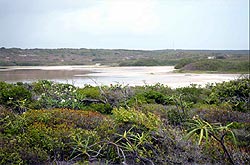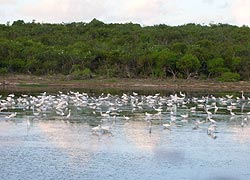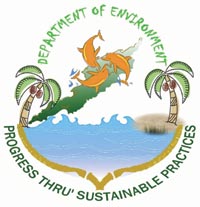Biodiversity is Our Business –
 |
|
A red mangrove-lined saltpond on Scrub Island. (photo by J.
Cestero) |
As a small, low-lying island without lakes, rivers, or streams,
Anguilla’s salt ponds represent the only real wetlands on the island.
Located between the island’s bays and more “upland” areas, Anguilla’s
salt ponds are places that are regularly flooded with fresh, brackish,
or salty water. As such, they can form anywhere that standing water can
gather. Salt ponds can be present year-round, seasonal, or appear rarely
and usually after high tides or heavy rains. While their appearance may
vary, all wetlands must be saturated with water for at least a week
during every growing season to qualify as a “wetland.”
There are twenty-five main salt ponds scattered throughout the island’s
mainland. Twenty-two of these ponds were formed naturally hundred and
thousands of years ago. The others, meanwhile, were constructed through
landscaping efforts. Regardless of when or how they were formed, though,
the size, salinity, depth, and nutrient composition of all of these salt
ponds influence the makeup, ecological processes, and diversity of the
organisms that call these special places home.
Without salt ponds, Anguilla would be a completely different place. So
why are they so important and what exactly do they do?
- Flood control. Salt ponds are able to prevent the flooding of
roads, farms, businesses, and homes by providing a place for excess
rainfall to be absorbed and held. They also protect fragile and
sensitive coral reefs and seagrass beds by catching, holding, and
filtering fresh water before it can reach them. The value of the
flood control services provided by Anguilla’s salt ponds is
estimated at almost EC$3 million annually.
-
 |
|
Grey Pond is separated from
the Atlantic Ocean by sand dunes. (photo by J. Cestero) |
Coastal protection. Salt ponds protect shorelines from tropical
storms and hurricanes by acting as buffers to strong surfs, high
tides, gale-force winds, and surges of the sea that often come with
such severe storms. The roots of the mangrove that line many of Anguilla’s ponds help to bind and stabilise soils along the coast
and help limit coastal erosion.
- Sediment traps. Salt ponds trap sediments that are washed onto
the coast from more upland areas and this helps to protect reefs and
seagrass beds since too much sediment can suffocate corals, clog the
gills of fish, and bury the eggs of the aquatic animals that use
these areas. Sediments also tend to include large amounts of
dangerous nutrients and substances from fertilisers and pesticides
that are washed into coastal waters from agricultural and heavily
manicured lawns and landscapes. Both high nutrient and sediment
levels can cause algal blooms and high turbidity (cloudiness) which
limits the amount of light and oxygen in the water. Too little light
could, in turn, stunt the growth of coral reefs and aquatic plants.
Salt ponds are not only able to just stop those contaminants from
getting into the sea, they can often change them through biological,
chemical, and physical processes into harmless substances.
- Water supply. salt ponds are sources of fresh, unpolluted water
that we need for drinking, washing, irrigation, and industry. They
are able to recharge groundwater supplies and act as filtering
systems that screen water of impurities and return clean water to
the aquifers. In some salt ponds, there are springs that supply
communities with water.
- Nurseries for marine fishes. salt ponds are extremely productive
ecosystems. They trap carbon and fix substantial amounts of nitrogen
annually. During this process, nitrogen is converted into compounds
that can be used by plants (for example, ammonia). This forms the
basis for wetland and marine food webs which include decomposing
organic matter, plants, crustaceans, worms, fish, birds, and many
other organisms. It is also estimated that over 80% of the world’s
commercial fish, including grouper, snapper, jack, and conch live in
mangroves at some stage of their life. Fish tend to spawn in reefs
and the young fish that are produced are swept towards land and into
the seagrass and mangrove root system through currents and tides.
Juvenile fish (of at least 400 species) are known to find shelter,
protection, and food in these ecosystems. Thus, these coastal
wetlands act as nursery grounds for marine fisheries.
- Waste treatment. The waters that surround Anguilla have relatively
few nutrients in them and this creates the perfect environment for
coral reef growth. Too many nutrients provide more than enough food
for algae which can easily grow out of control. Algal over-growth
can suffocate the other organisms found in the water, including the
coral. salt ponds are able to breakdown some of these dangerous
nutrients including nitrogen which is contained in the fertilisers
used on lawns and gardens that often drain into the coastal water
system.
- Salt pond products. In Anguilla, salt was harvested for export
from salt ponds up until the 1970s. Birds also used to be hunted and
the Amerindians used to use the island’s mangroves as an important
source of building material and firewood.
-
 |
|
Snowy and great egrets on
East End Pond Conservation Area. (photo by F. Mukhida) |
Habitat for wildlife and endangered species. salt ponds are so
productive that they serve as habitat for birds, fish, mammals,
invertebrates, and plants – all of which are interconnected through
a massive food web. Approximately 80% of all Caribbean breeding bird
populations depend on salt ponds at some point in their lives and
almost all Caribbean commercial fish and shellfish species depend,
to some extent, on wetlands. Therefore, without this habitat, they
would not be able to survive. Anguilla’s salt ponds are also
extremely important conservation areas. There are over 130 species
of birds reported in Anguilla – at least half of which are dependent
upon salt pond habitats – and nearly 25 percent of these species are
considered to be threatened either regionally or globally.
The importance of the island’s salt ponds is addressed indirectly
within Anguilla’s 2008 National Biodiversity Strategy and Action
Plan (NBSAP). The NBSAP integrates management strategies for
Anguilla’s salt ponds into larger plans of action for coastal and
in-land areas. The Plan, therefore, recommends that:
- Relevant environmental agencies enhance their capacity to manage
these areas;
- Relevant Government of Anguilla Departments and other agencies
develop and implement legislation and regulations along with
programmes and projects that help to maintain and protect these
areas; and
- Environmental awareness and education programmes about Anguilla’s
biodiversity, including that which is found in salt ponds, is
raised.
Anguilla’s saltpond are wondrous places. Their soft muddy bottoms to
their tree-lined shores are rich with intricate networks of diverse,
complex, and important life-forms. From the water-skimming flies to
the juvenile fish seeking protection, to the salt-tolerant
mangroves, Anguilla’s salt ponds are more than just mosquito- and
black-fly-ridden waters, or places to dump garbage, or wasted space
that could be in-filled and built on. These ponds are productive
habitats that work with and support the functions of Anguilla’s
other ecosystems – from its coastal coral reefs and beaches to its
in-land scrub land; they need as much attention, consideration, and
protection as the rest of Anguilla’s natural environment.
Information for this article was sourced from: Amoy Lum Kong’s
Report on the Anguilla Fisheries/Marine/Coastal Sector (2008);
Patricia Bradley’s (et al) Wondrous West Indian Wetlands: A resource
book on Caribbean wetlands for teachers and other educators.
Funding for this article was provided by the Overseas Territories
Environment Programme through the Department of Environment
(Government of Anguilla).
|





